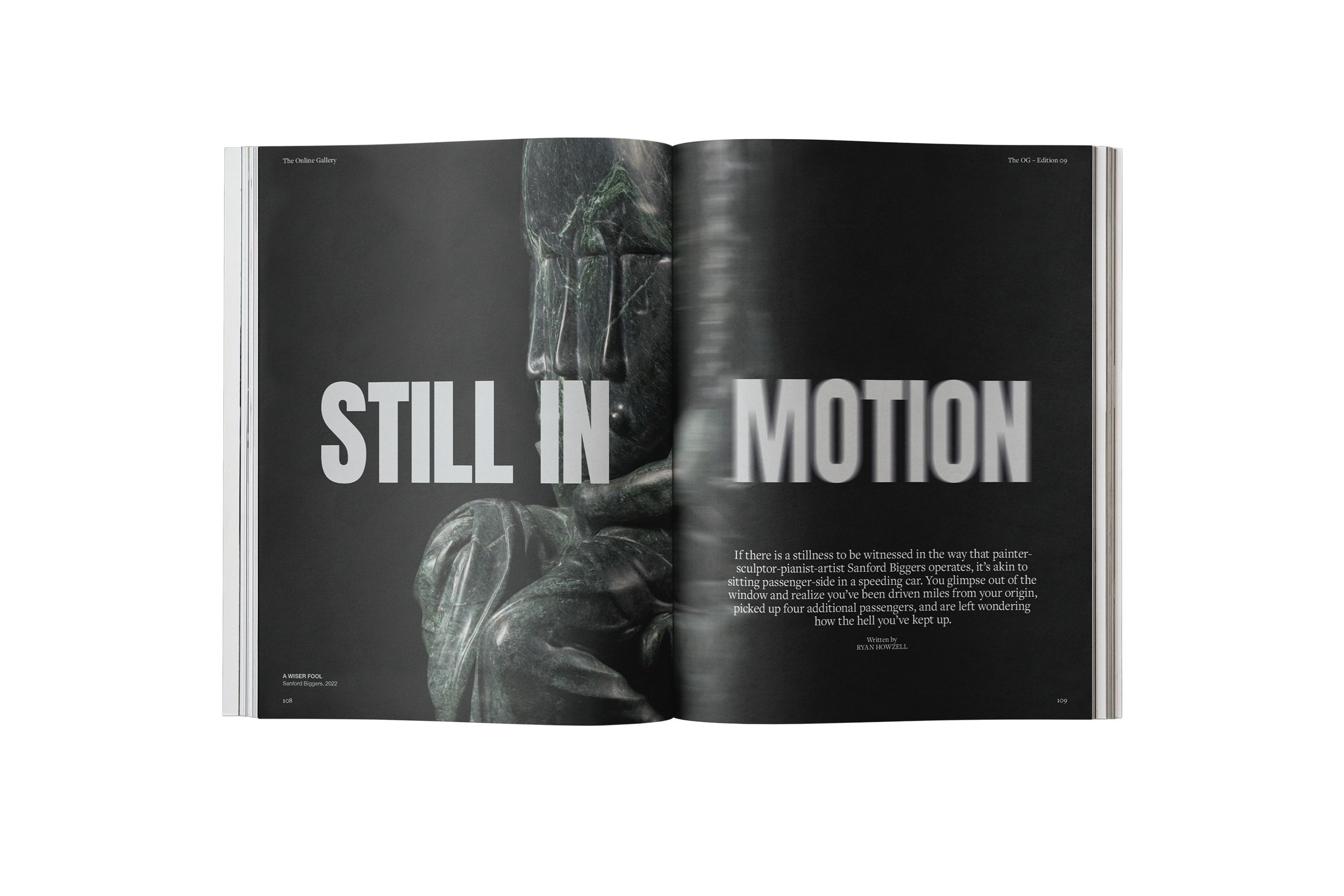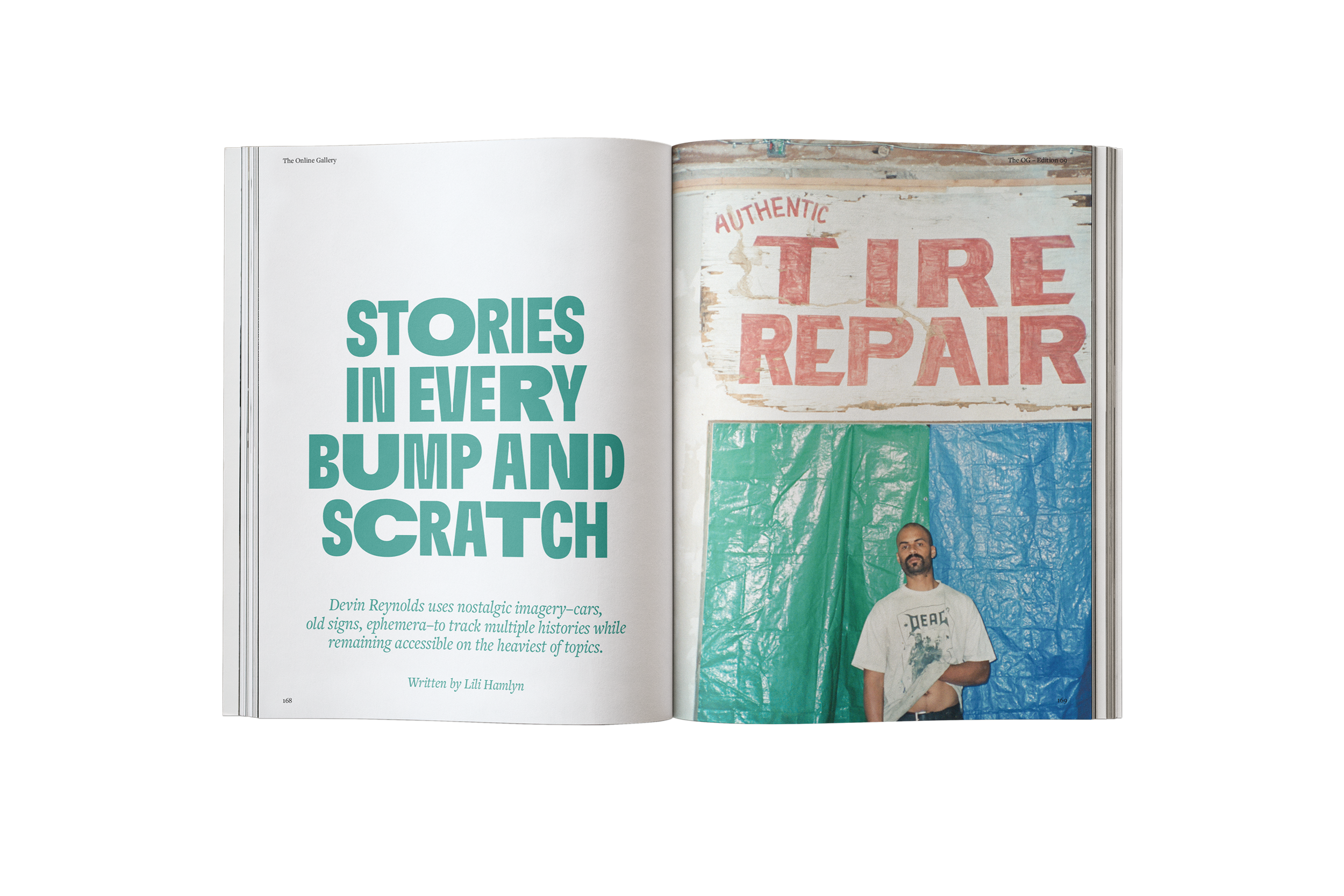In Edition 9, we double down on our commitment to creatives, culture, and community. We’re most interested in the intersections that bind these three pillars together, how creativity begets community, how community creates culture, and how culture becomes fertile ground for further creative output, whether it be Genevieve Gaignard’s series that unsettle gender and race tropes with the lethal playfulness of a cat batting around a mouse, or College Track Crenshaw’s unstintingly unsentimental commitment to vitalizing students before, through, and after college. Edition 9 relishes the endlessly diverse, un-pin-down-able flourishings of aesthetic vitality, from the edgy nostalgia of Jason Thomes’s Yeah, I Work Out movement to Sanford Biggers’s Buddhist-level cool. Join us to celebrate community: the people that make it and the art that consolidates the fact of being here, together.
Front & Back Cover Artwork By: Sanford Biggers
Edition 9
FEATURED
FEATURED
Genevieve
Gaignard
In her collage work and self-portraiture, Genevieve Gaignard conjures unsettlingly banal realities of American life. Be it a white neighbour observing from her window for concerning situations or a blonde feminine character spreading a flag of the American 100 dollar bill across her back, she makes vivid the bubbles that occupy different modes of living and being in American households. Gaignard's work muddles the beautiful, personal, and political, and her works have been known to depict the historical and cultural experiences and struggles of Black life and informing them with white American pathologies. Her works such as "White Lies" and "And If You Don't Know, Now You Know" questions and cleanses reference and past, imploring us to think more about a politics of historical and futural reassembly.
Justen
Leroy
To Justen LeRoy, sound is more than texture, a means towards realizing art projects. It is a language, an experience, that shifts, evolves, and informs his life and craft. In the creative process, LeRoy sees it as an expansive domain of worldmaking, world-connecting. "You learn to listen, because listening can bring you into new worlds." As LeRoy talks about his first solo multimedia exhibition on the entanglements between Black bodies and environmentalism, he discusses growing up in the Crenshaw neighborhood, the shifting qualities and histories of sound that inform his personal life, and the complicated experiences when engaging with sound.
Jason
Thome
Jason Thome desires to return bodybuilding to its artistic roots. Muscle beach was and is a wonderful melange of color, graphics, and iconography, exulting the transformative potential of muscles and our bodies. Thus, Thome is not simply a designer but also an archivist, revitalising the "golden age of bodybuilding." The muscle poses of Arnold Schwarzenegger, Frank Zane, and Ed Corney inspire Yeah, I Work Out (Y,IWO)'s aesthetic and history, mustering apparel, graphics, zines, and photography that make things that are artistic, authentic, and functional.
Derrick
Adams
Black Baltimore Digital Database deterritorializes, challenging the exclusions, omissions, and ignorance of public archives and history in its attempt to recover and reconcile with the complex histories, experiences, and objects of Black people in Baltimore. As such, they function as a "counter-institutional" space, and part of that philosophy invites collaborations with citizens, neighbours, and visitors to learn the tools of archiving, to lend themselves in the collective work of making archives and memories. Even the design of BBDD is informed by an interpersonal aesthetics, becoming a welcoming space akin to a church or a family home. To the members of BBDD, archiving is a deeply social process, so the work begins with an honest engagement with community that has and continues to live on the historical land of Baltimore.
Wintor
McNeel
College Track's work remains urgent. The Covid-19 pandemic exacerbated educational inequities in our education system, requiring resources and support to help disadvantaged students who can't wait for difficult and promised but never arriving systemic overhaul. Thus College Track's commitment--a 10-year process that includes recruitment, preparation for the college application process, navigating four years of college, and further guidance after graduation and beyond. Ken Miles talks to Dr. Wintor Ashley McNeel, the newly appointed site director with old roots to Crenshaw. They talk about struggles and experiences of Crenshaw, navigating access and opportunity, and providing transformative exposure to deserving students.
Kennedy
Yanko
Wrought metal sculptures become the surface for Kennedy Yanko's signature "paint skins." These skins are made of dried industrial paint, endowing scrap metal with aesthetic and meaning. Such precise interpellation between metal and paint, between refuse and reuse, governs Yanko's "call-and-response" approach, a conversation between two voices. As such, she responds to the unique concerns that appear with each sculpture she works with, paying much care to the needs of the material she finds and works with. This is all as a vision to realize the transmutation of many voices in the artist's mind into the physical realm, welding together intuition and the material, imagination and the real.
Andrea
Bowers
Grounded in the orbit of activist work, Andrea Bowers' craft comes with careful understanding of local contexts and battles. When invited to show her works, she finds activists on the ground to ask how can she help. As such, Bowers' works are steeped in mutual aid and learning. Her approach renders her pieces in an interdisciplinary light, as she works on transfeminism, environmentalism, and issues of immigration. The quickness of activist movements contrasts with the radical patience of her approach to art, slowing the reader down, transfixing them with images, a message. Her works garner immediate, striking attention, yet their sticky iconography leaves an imprint on the reader, encouraging lasting thoughts and revisits.
Sanford
Biggers
As Sanford Biggers explains, "any object has the capacity to be come activated or charged, whether through an artist's devotion, an audience's engagement, or in many cases , the kinetic dialogue between the two." This energy accompanies the objects of the world-renowned interdisciplinary artist, who cuts, paints, distorts, layers, and tears into American history. His deftness with different media allows him to teeter in between sculptures, music, and even a "quilt" made of sand, negotiating materiality and temporality in the tender ephemeral nature of his work. And behind his approach lies his desire to be still, taking, and distinguishing, time seriously, amidst the cacophany of life and work.
Rodney
McMillian
In structures, CalArts Professor Rodney McMillian, finds a set of meanings in friction with each other. One of his installations, a church hand sewn in red vinyl, explores the dualisms of class and access, indoctrination or salvation, a gathering place and safe space. He is compelled to make richly layered sites that bloom contained objects to national proportions. All along he asks the question: "what forces are needed for justice to become malleable?" As a sculptor, he grapples with both the metaphorical and material quality of this meaning, tapping in communal, historical, and political genealogies.
Derek
Fordjour
Derek Fordjour's paintings have texture and dimension. The scenes he paints are tessellated, mosaic-like, such that even blank spaces on the canvas are laden with atmospheric intention. These rich backgrounds then contrast with the harmonic energy of his subjects: people in activity; people in unison. His figures move and play, and they are gestures forming a cultural choreography of lively communities and the activities they cherish. The energy and emphasis on athletic achievement reference both Black aspiration and his parents' Ghanaian background. He captures purposeful yet durational moments into arresting celebrations of the rituals of community.
Olympia
Auset
No community would survive, much less thrive, without food. And here with SÜPRMARKT LA,Olympia Auset battles manmade food apartheid. Understanding food deserts as a design problem linked fundamentally with systems of oppression, Auset conceptualizes such food precarity as solvable. SÜPRMARKT taps into the inefficiencies and inequities of the food supply chains to create new avenues of food distribution so that more people have access to food and less food goes to waste. Auset seeks to repair our relationship with food, elevating food as a creative space and revitalizing communities in need.
Devin
Reynolds
Devin Reynolds is inspired by fishing boats in Southern California, architecture in Florence and Rome and street artists in Italy and Berlin. Yet his paintings reveal more diverse influences. Car culture, street art, figurative work, surf culture, commercial graphic design, and signage are all fair game in the vision of his paintings. His works evoke plurally rich histories just as they raise the question of the anonymity and gradual erosion of the street artist's personal identity in the making of commercial and public art.













